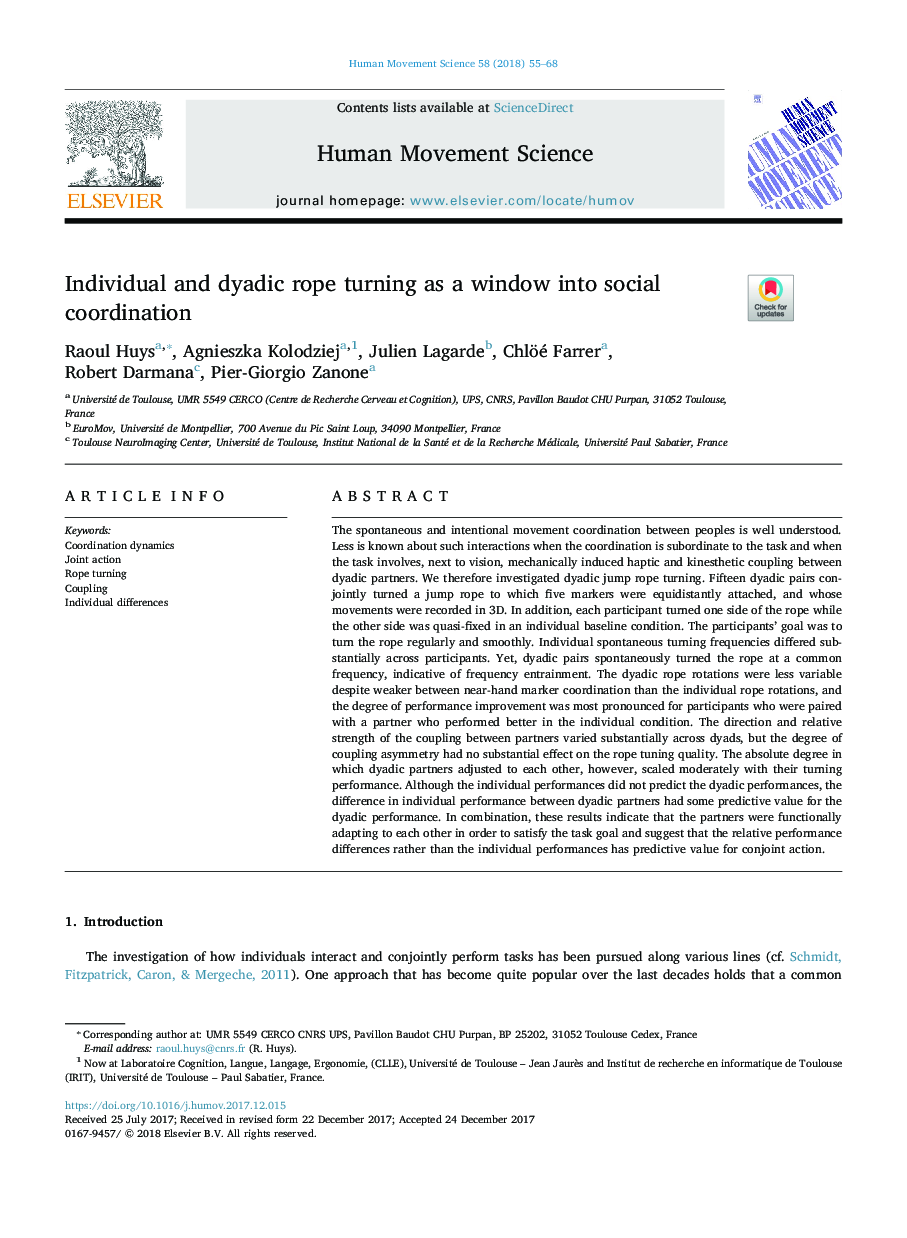| کد مقاله | کد نشریه | سال انتشار | مقاله انگلیسی | نسخه تمام متن |
|---|---|---|---|---|
| 7290913 | 1474206 | 2018 | 14 صفحه PDF | دانلود رایگان |
عنوان انگلیسی مقاله ISI
Individual and dyadic rope turning as a window into social coordination
ترجمه فارسی عنوان
طناب فردی و دایادیک به عنوان یک پنجره به هماهنگی اجتماعی تبدیل می شود
دانلود مقاله + سفارش ترجمه
دانلود مقاله ISI انگلیسی
رایگان برای ایرانیان
کلمات کلیدی
دینامیک هماهنگی، اقدام مشترک، چرخش طناب، جفت، تفاوتهای فردی،
موضوعات مرتبط
علوم زیستی و بیوفناوری
علم عصب شناسی
علوم اعصاب شناختی
چکیده انگلیسی
The spontaneous and intentional movement coordination between peoples is well understood. Less is known about such interactions when the coordination is subordinate to the task and when the task involves, next to vision, mechanically induced haptic and kinesthetic coupling between dyadic partners. We therefore investigated dyadic jump rope turning. Fifteen dyadic pairs conjointly turned a jump rope to which five markers were equidistantly attached, and whose movements were recorded in 3D. In addition, each participant turned one side of the rope while the other side was quasi-fixed in an individual baseline condition. The participants' goal was to turn the rope regularly and smoothly. Individual spontaneous turning frequencies differed substantially across participants. Yet, dyadic pairs spontaneously turned the rope at a common frequency, indicative of frequency entrainment. The dyadic rope rotations were less variable despite weaker between near-hand marker coordination than the individual rope rotations, and the degree of performance improvement was most pronounced for participants who were paired with a partner who performed better in the individual condition. The direction and relative strength of the coupling between partners varied substantially across dyads, but the degree of coupling asymmetry had no substantial effect on the rope tuning quality. The absolute degree in which dyadic partners adjusted to each other, however, scaled moderately with their turning performance. Although the individual performances did not predict the dyadic performances, the difference in individual performance between dyadic partners had some predictive value for the dyadic performance. In combination, these results indicate that the partners were functionally adapting to each other in order to satisfy the task goal and suggest that the relative performance differences rather than the individual performances has predictive value for conjoint action.
ناشر
Database: Elsevier - ScienceDirect (ساینس دایرکت)
Journal: Human Movement Science - Volume 58, April 2018, Pages 55-68
Journal: Human Movement Science - Volume 58, April 2018, Pages 55-68
نویسندگان
Raoul Huys, Agnieszka Kolodziej, Julien Lagarde, Chlöé Farrer, Robert Darmana, Pier-Giorgio Zanone,
